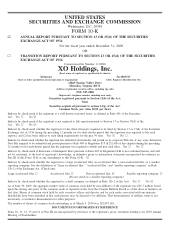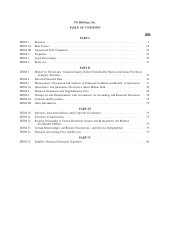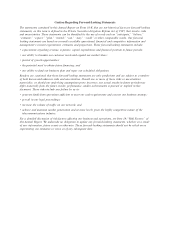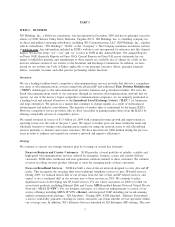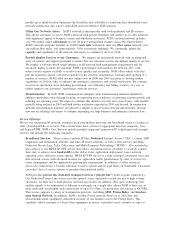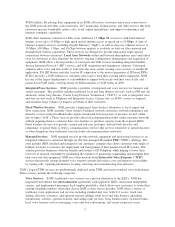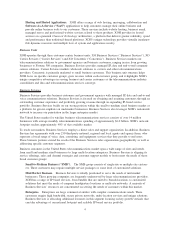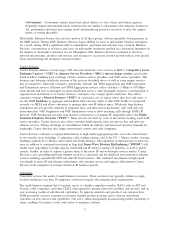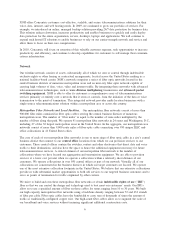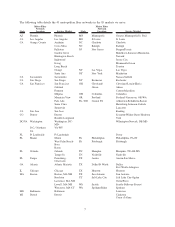XO Communications 2009 Annual Report Download - page 10
Download and view the complete annual report
Please find page 10 of the 2009 XO Communications annual report below. You can navigate through the pages in the report by either clicking on the pages listed below, or by using the keyword search tool below to find specific information within the annual report.XOH offers Concentric customers cost-effective, scalable, and secure telecommunications solutions for their
voice, data, internet, and web hosting needs. In 2009, we continued to grow our portfolio of services. For
example, we introduced an online, managed backup solution providing 24/7 data protection for business data.
This solution reduces downtime, increases productivity and enables businesses to quickly and easily deploy
data protection for the entire organization, servers, desktops, laptops and applications. We will continue to
expand such hosted IT solutions to enable businesses to rely on our carrier-strength network and service and
allow them to focus on their core competencies.
In 2010, Concentric will focus on retention of this valuable customer segment, seek opportunities to increase
productivity and efficiency, and continue to develop capabilities for customers to self-manage their communi-
cations infrastructure.
Network
Our wireline network consists of assets, substantially all of which we own or control through indefeasible
exclusive rights or other leasing or contractual arrangements, located across the United States making us a
national facilities-based carrier. XOH’s network comprises a series of fiber optic networks located in the
central business districts of numerous metropolitan areas and an inter-city fiber optic network capable of
carrying high volumes of data, voice, video and internet traffic. By integrating these networks with advanced
telecommunications technologies, such as wave division multiplexing transmission and advanced packet
switching equipment, XOH is able to offer its customers a comprehensive array of telecommunications
services primarily or entirely over a network that it owns or controls, from the initiation of the data or voice
transmission to the point of termination. This integrated network provides multi-location businesses with a
single-source telecommunications solution within a metropolitan area or across the country.
Metropolitan Fiber Networks and Local Facilities. Our metropolitan fiber networks consist of more than
900,000 fiber miles contained in fiber optic cables serving the central business districts of numerous
metropolitan areas. The number of “fiber miles” is equal to the number of route miles multiplied by the
number of fibers along that path. We operate 41 metropolitan fiber networks in 24 states and Washington, D.C.,
including 27 of the 30 largest metropolitan areas in the United States. In the aggregate, our metropolitan area
networks consist of more than 9,000 route miles of fiber optic cable connecting over 950 unique ILEC end-
office collocations in 41 United States cities.
The core of each of our metropolitan fiber networks is one or more rings of fiber optic cable in a city’s central
business district that connect to our central office locations from which we can provision services to our
customers. These central offices contain the switches, routers and other electronics that direct data and voice
traffic to their destinations, and also have the space to house the additional equipment necessary for future
telecommunications services. A critical element of our metropolitan fiber network is the number of
collocations where we have located our aggregation and transmission equipment. We are able to provision
services at a lower cost per unit when we operate a collocation within a relatively short distance of our
customers. We operate collocations in over 950 central offices as part of our network. Virtually all of our
collocations are concentrated in the business districts in which our target customers are located. We operate
one of the most extensive collocation footprints in the United States. We believe that our extensive collocations
provide us with substantial market opportunities to both sell services to our targeted business customers and to
serve as points of termination for traffic originated by other carriers.
We strive to build and own these metropolitan fiber networks or obtain indefeasible rights of use (“IRU”)
fiber so that we can control the design and technology used to best meet our customers’ needs. Our IRUs
allow us to use a specified amount of fiber on those cables for terms ranging from 10 to 30 years. We built
our high capacity metropolitan fiber networks using a backbone density ranging between 72 and 432 strands
of fiber per cable. Fiber optic cables have the bandwidth to carry tens of thousands of times the amount of
traffic as traditionally-configured copper wire. Our high-count fiber cables allow us to augment the scale of
our broadband and voice services without incurring significant additional construction costs.
6


